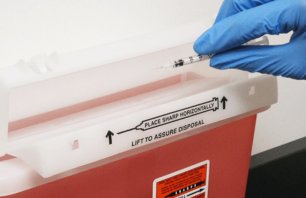Sharp instruments, including needles and syringes, are commonly used across the healthcare industry. Proper disposal of these items after use is essential to helping preserve the safety of healthcare workers, patients, and the environment.
According to the Centers for Disease Control and Prevention (CDC), approximately 385,000 needlesticks and other sharps-related injuries are sustained by hospital-based healthcare personnel annually in the U.S.
As part of the healthcare workforce, nurses are a crucial stakeholder in sharps waste management. When nurses encounter overfilled sharps containers, it can take them away from patient care and may increase the risk of needlestick injuries. Nurses handle sharps waste frequently during their workday. According to a report by the International Safety Center on Needlestick and Sharp Object Injuries, nurses accounted for approximately 40% of needlestick injuries experienced in certain healthcare settings, followed by specialist physicians at 16%.
Needlestick injuries not only expose nurses and healthcare workers to the risk of infection via bloodborne pathogens, but they can also impact healthcare organizations’ bottom lines. For example, following a needlestick injury at work, a nurse may need to take paid sick leave, may require medical attention such as lab tests, or the Occupational Safety and Health Administration (OSHA) might impose civil penalties on the organization.
New Findings on the Importance of The Proper Disposal of Sharps Wastes
To dig deeper into the challenges nurses face and the role that medical waste management partners can play, Stericycle sponsored an independently administered nationwide blind survey of 125 randomly selected nurses in hospital and outpatient settings. Of the nurses surveyed by Stericycle, 66% reported disposing of sharps ten or more times per day, with 19% disposing of sharps 4 to 9 times daily. Other noteworthy findings of the survey include:
- Effective and reliable sharps waste management solutions can help alleviate nurses’ workloads by reducing the time spent switching out full sharps containers. Of those surveyed, 57% of nurses agreed that their organization would benefit from a more frequent sharps disposal exchange schedule to eliminate sharps disposal containers being filled above the recommended fill line.
- Nurses value sharps waste management solutions that are simple and easy to use. A full-service sharps waste management solution, which consists of a dedicated and consistent container exchange schedule that is managed by a medical waste management partner, can support nurses by helping reduce the risk of needlestick injuries associated with overfilled containers and allowing nurses to focus on patient care instead.
- Comprehensive instructional materials can help healthcare workers stay informed and engaged. Of the nurses surveyed by Stericycle, 78% agreed that instructional materials such as posters and handouts help clarify proper sharps disposal methods.
- In-depth training and ongoing support are critical for sharps waste management solutions to be successful. The CDC’s Stop Sticks campaign identifies proper education on sharps disposal as a key factor that can drive reductions in needlestick injuries. Of the nurses surveyed by Stericycle, 35% said that more training materials are needed for them and other nursing staff to utilize sharps containers safely.
- In addition to a full-service sharps waste management solution with proactive container exchange, the type of container used could also play a role in safe disposal. According to those surveyed by Stericycle, nurses prefer vertical containers.
Benefits of a Full-Service Sharps Waste Management Solution
Taking time to understand what is involved in safe sharps waste disposal is important to help ensure organizations are effectively managing this common waste stream.
A full-service solution can support nurses by helping reduce the risk of needlestick injuries associated with overfilled containers, reduce burdensome waste disposal duties, and support short-staffed Environmental Services (EVS) departments. Findings in the most recent Stericycle survey show that a full-service solution that prevents containers from overfilling, the correct training tools, and containers that match nurses’ preferences are important aspects to consider.
Hospitals and integrated delivery networks should keep these in mind when implementing a sharps waste program so that nursing staff can dedicate their time to what matters most: patient safety and care.
Learn more about how Stericycle’s sharps waste management solutions and resources can help healthcare providers and the patients they care for.
Frequently Asked Questions
What is Sharps Waste?
Sharps waste is a particular category of infectious waste that includes syringes, needles, lancets, shattered glass, and other items that can puncture or cut through the skin. Due to their potential to breach the skin's protective barrier and become contaminated with pathogens, sharps waste poses a significant threat to human health. From a safety perspective, sharps are considered one of the most hazardous waste types generated in healthcare settings.
What are Needlestick Injuries?
A needlestick refers to when a sharp pierces the skin barrier.
Who is at Risk of Needlestick Injuries?
According to The National Institute for Occupational Safety and Health (NIOSH), healthcare personnel who use or may be exposed to needles are at increased risk of needlestick injury. All workers who may potentially come into contact with needles, such as doctors, lab workers, housekeepers, and nursing staff, are at risk of needlestick injuries. Needlestick injuries can lead to serious or fatal infections from bloodborne pathogens such as Human Immunodeficiency Virus (HIV), Hepatitis B virus (HBV), and Hepatitis C virus (HCV).
What Practices Can Increase the Risk of Injury?
Certain practices may heighten the possibility of needlestick injuries, including:
- Failing to employ safety-engineered sharps or utilizing them improperly
- Recapping needles after use
- Transferring bodily fluids between containers
- Failing to correctly dispose of used needles in sharps containers that are puncture-resistant



